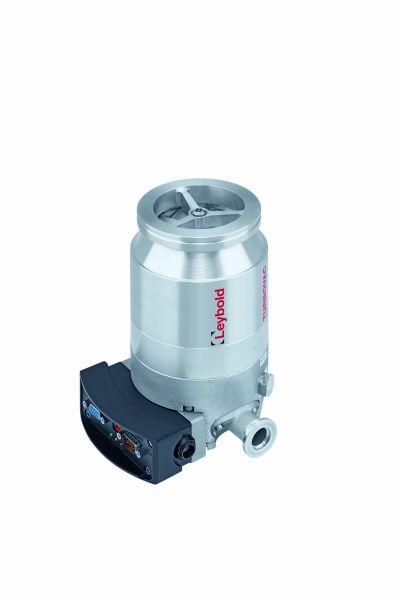TURBOVAC 90 i/iX
| Velocità di pompaggio (Ar): | 83 l/s |
| Velocità di pompaggio (He): | 90 l/s |
| Velocità di pompaggio (H₂): | 78 l/s |
| Velocità di pompaggio (N₂): | 90 l/s |
TURBOVAC 90 i/iX
Turbomolecular vacuum pumps (TURBOVAC) are used in applications which require a clean high or ultrahigh vacuum like, for example, in research, development or in industrial fields like the semiconductor industry, analytical instrumentation or coating technology.
Principle of Operation
In principle, the turbomolecular pump is a turbine rapidly revolving in a housing where the rotor stages of the turbine Sectional drawing of a turbomolecular pump (TURBOVAC i) are equipped with a number of rotor blades. Located between the rotating rotor blades are stationary stator disks with blades arranged in the opposite direction. By means of a momentum transfer from the rotating rotor blades to the gas molecules their initially nondirectional thermal motion is changed in to a directional motion from the inlet flange of the pump in the axial direction towards the forevacuum flange. In the molecular flow range (i.e. at pressures below 10-3 mbar (0.75 x 10-3 Torr)) the mean free path of the gas molecules is larger then the spacing between the rotor and the stator blades (typically a few tenths of a millimetre). Correspondingly the molecules chiefly collide with the optically dense rotor blades, resulting in a highly efficient pumping action. In the laminar flow range (i.e. at pressures over 10-1 mbar (0.75 x 10-1 Torr)) the effect of the rotor is impaired by frequent collisions between molecules themselves. For this reason, a turbomolecular pump is not capable of pumping gases at atmospheric pressure.
Rotor Bearing
Leybold offers different rotor bearing systems. A purely classic mechanical type of rotor bearing (TURBOVAC) or a magnetic rotor bearing (TURBOVAC MAG) and also a hybrid bearing (TURBOVAC i / iX) where the bearing on the forevacuum side is a ceramic ball bearing lubricated for life and where the bearing on the high vacuum side is implemented by way of a non-wearing magnetic bearing. Typical for all these types of bearing is that they do not require any lubricating oil which under circumstances like standstill of the pump might diffuse back into the vacuum chamber due to the lack of any pumping action.
Drive Electronics/Control Unit
Driving and monitoring the turbomolecular pump requires an electronic frequency converter (inverter). The frequency converter delivers the driving voltage and the output frequency for the motor and also automatically monitors the system. Optimum running up of the pump rotor is attained by a steadily increasing voltage and frequency feed. After attaining the nominal speed, the start-up current is reduced in a controlled manner to the level necessary for normal operation.
The frequency converter and the motor of the TURBOVAC have been designed for a minimal drop of speed even at high intake pressures. This ensures the highest possible gas throughput also in the transition range from molecular to viscous flow.
Depending on the given system and installation conditions, the control unit may be supplemented by a comprehensive range of optional accessories facilitating easy integration within existing installations.
Forevacuum Pump
Since turbomolecular pumps are not capable of compressing directly against atmospheric pressure their operation will always require a sufficiently rated forevacuum pump. For the classic rotor arrangement with rotor blades, generally two-stage rotary vane pumps (TRIVAC) will be suitable. In some cases also single-stage rotary vane vacuum pumps (SOGEVAC BI) or scroll vacuum pumps (SCROLLVAC).In the case of the wide range variant where the rotor is equipped with an additional compression stage (compound stage) also diaphragm vacuum pumps (DIVAC) may be used.
Characteristic Quantities
Pumping speed (volume flow rate)
The pumping speed “S” is the conveyed volume flow through the intake opening of the pump. It is dependent on the type of gas so that for this reason the nominal pumping speed, i.e. the maximum attainable pumping speed of the pump is commonly stated for air, respectively nitrogen. In the field of high vacuum engineering it is common to state the pumping speed in the unit of measurement [l/s]. The pumping speed is a nonlinear function of the inlet pressure S = S(p1).
Gas throughput
Gas throughput “Q”, unit of measurement [mbar x l/s] is linked to the pumping speed through the inlet pressure. Q = Q(p1) = p1 * S(p1).
Compression
Compression “K” is defined as the ratio between the pressure on the forevacuum side of the turbomolecular pump and the pressure on the high vacuum side. K = K(pVV) = pVV/pHV. Compression is dependent on the type of gas.
Ultimate pressure (base pressure)
The ultimate pressure “pult” of a turbomolecular pump which can be baked out is defined through the ratio between forevacuum pressure and compression ratio which is attained in a test chamber 48 hours after a 24-hour bake-out (degassing) of the measurement arrangement. pult = pFV/K0.
The maximum attainable ultimate pressure depends among other things on the cleanness of the apparatus, the type of forevacuum pump used, the types of seals used for the high vacuum flange and the bake-out conditions.
- Product Overview (9.83 Mb)
- Declaration of contamination (HS1) (531.93 Kb)
- Declaration of contamination (HS2) (602.15 Kb)
- Dichiarazione di contaminazione (HS1) (497.16 Kb)
- Dichiarazione di contaminazione (HS2) (613.18 Kb)
- Fundamentals of Vacuum Technology (5.01 Mb)
- Product catalogue (14.27 Mb)
- Service catalogue (1.71 Mb)





